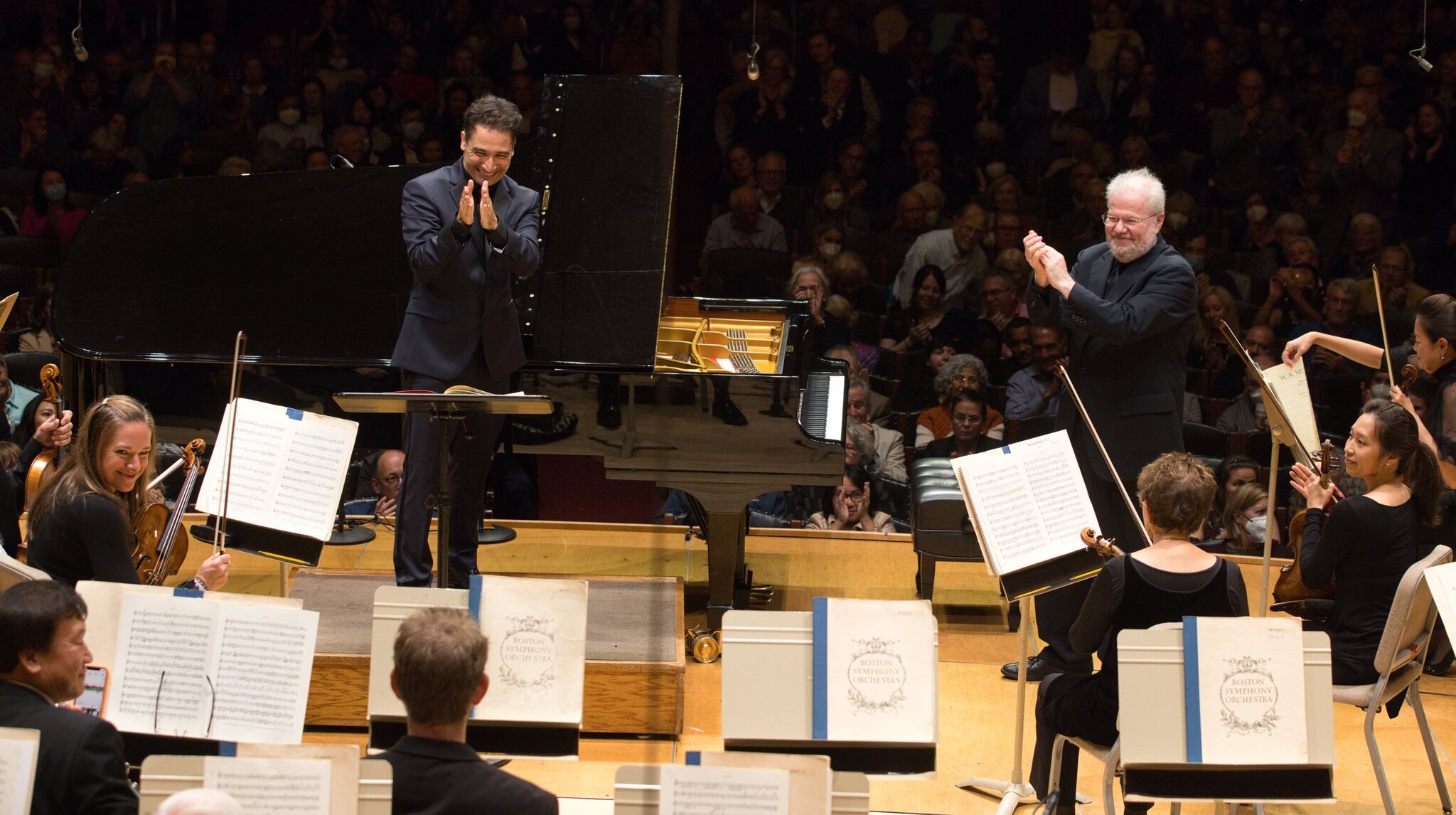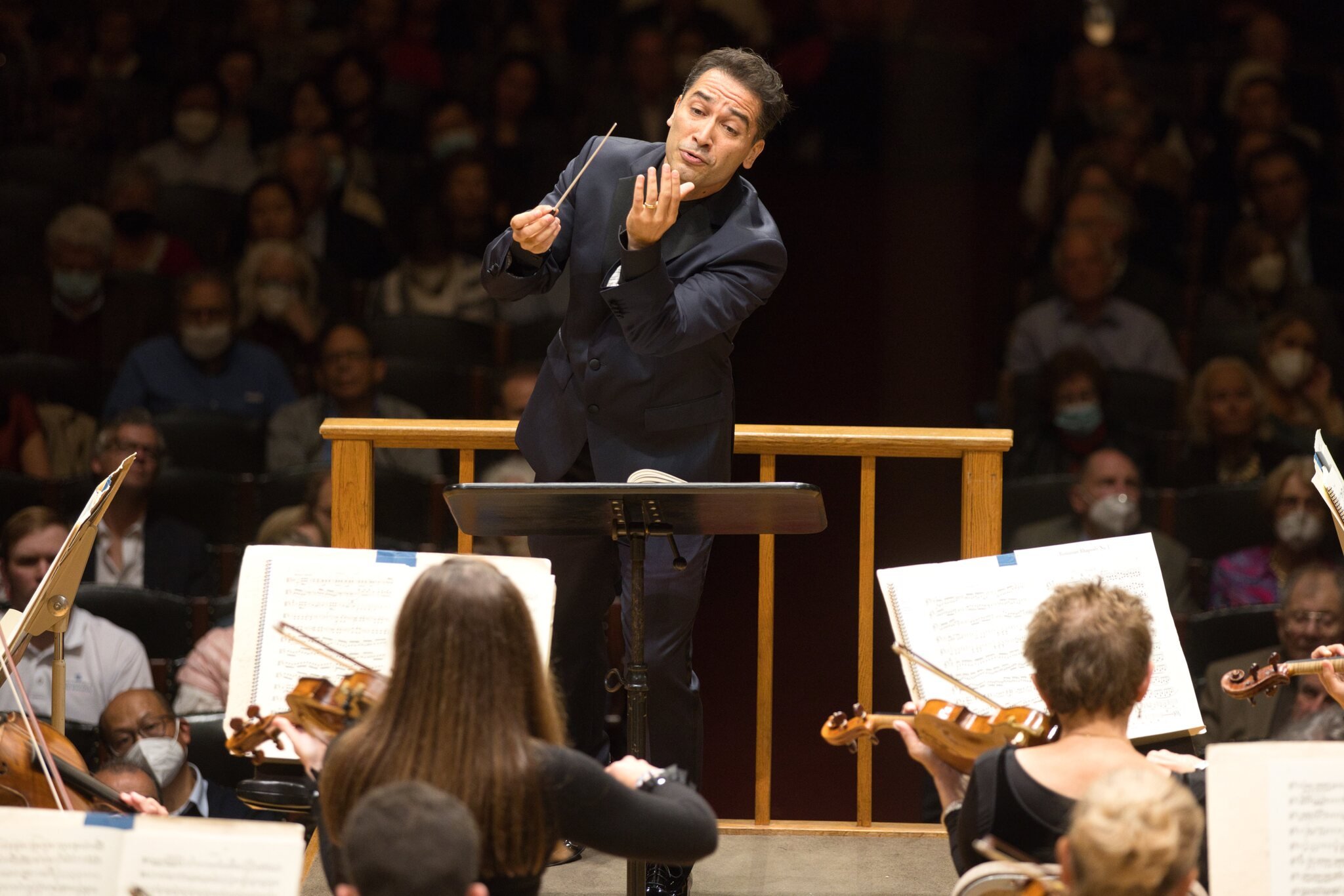A BSO Debut: Miraculous
Written for and published by the Boston Musical Intelligencer on 14 October 2022
Balanced, colorfully varied works from the standard repertory characterized conductor Andrés Orozco-Estrada’s BSO conducting debut last night: Tchaikovsky’s evergreen Romeo and Juliet Fantasy Overture, Bartók’s lurid pantomime suite from the Miraculous Mandarin, and Enescu’s spirited Volkbild the Romanian Rhapsody in A, alongside the valedictorian poetry of piano soloist Emmanuel Ax’s refined take on Mozart’s elegant Piano Concerto, K. 456. The evening’s aural menu gave listeners a broad scope of aesthetic pairings that kept one enthusiastically engaged throughout.
Tchaikovsky’s Romeo and Juliet Fantasy Overture stands among his most enduring symphonic masterpieces, if also something of a kitsch symphonic tradition to most orchestras and conductors. It is no less satisfying even if, in this instance, it acted as a warmup for both conductor and band to stretch their musical muscles before more demanding feats to come.
Andrés Orozco-Estrada and Emmanuel Ax (Hillary Scott, photo)
The slow, Friar Lawrence introduction was sumptuously blended among the winds, aided by dialogue with strings. This moment could only be criticized for its relative stiffness. The Montague-Capulet sword-fighting section of the work provided some elastic relief as the musicians could rhythmically flow with the driven music. A seamless transition marked the flow of the bellicose section to the first of the two famous affettuoso apotheose in the work: luxuriously pronounced by Robert Sheena on English horn. Streams of contrapuntal imitation clearly sounded from the strings and brass in the reemergence of the battle motif, all leading to the second, affettuoso passage climax. Orozco-Estrada led this moment with a perfectly intuitive sense of ritenuto at the precipice of the cadence. As the final fanfare chords lapsed into silenced, the resolute fin to la conte aux amants à la folie resulted in a moderate ovation.
Emmanuel Ax then joined reduced ranks of the BSO for a nuanced rendition of Mozart’s Piano Concerto in B-flat major, No 18. Orozco-Estrada achieved classical balance, a light and easy-going repartee of statements and thematic material as the basis for this quintessential Mozart. Ax phrased the first movement, Allegro vivace, with well-proportioned elegance, never languishing in tempo. The movement came as a verdant divertimento, even as circle-of-fifths modulations in the development portrayed some harmonic drama.
Good humor gave way to a serious, g-minor set of variations in the Andante. The melodic theme worked its way through stern half-step tilts in the root key, only to resolve in the relative major, B-flat. A melancholy scene of Mozartian introversion transfixed the listeners, as Orozco-Estrada phrased his forces in contrast to the embellished passages of Ax’s solo orations. Major mode variations provided some emotional relief, even if overshadowed by a bleak conclusion.
Proceeding with little pause, Ax launched into the rollicking, light-hearted Rondo, Allegro vivace. Marked with the same tempo as the first, it captured a greater spirit of liveliness from soloist and accompaniment. Real fun ensued in the grace-note patterns that chirped with humor; more drama transpired in the minore Rondo passage which Ax traversed with virtuoso gusto.
The major-minor moods of the Mozart concerto paired well alongside Ax’s well-earned encore: Schubert-Liszt’s Ständchen from Schwanengesang. Ax’s handling of the A-section return, with its voiced echoes, was particularly beautiful. As the break ensued, what appeared to be a masked Yo-Yo Ma discretely slipped out of the hall; he was no doubt there to support his good friend and long-time collaborator “Manny.”
After the break, Orozco-Estrada led his colleagues in an incisive, rhythmically charged rendition of Bartók’s Concert Suite from the Miraculous Mandarin. This work, most often presented as it was this evening in its concert suite form, is a pantomime ballet in one act that features large orchestra and wordless chorus (omitted in the concert suite arrangement). The Tchaikovsky earlier in the evening poised the topic of fated, naïve love, whereas the Bartók frames the Freudian shadows of the subconscious Id.
As Steven Ledbetter’s note explains:
Andrés Orozco-Estrada (Hillary Scott, photo)
The tale is lurid and violent, set in a brothel. At the rise of the curtain, three ruffians enter with a girl. Finding no money in her flat, they order her to go to the window and attract a customer. Three times she lures men into the room; the first two have no money, and the ruffians unceremoniously throw them out. Finally a mysterious “Mandarin” enters, his face revealing no sign of emotion except for his burning eyes, which stare ceaselessly at the girl. She begins dancing with increasingly sensuality, but when he embraces her, trembling with passion, she tries to elude him and he pursues her. The ruffians attack and rob him, then decide to kill him. They smother him, but he will not die, and continues staring at the girl. They stab him; he does not fall or bleed. They hang him from a chandelier; it comes crashing down, and his body begins to glow with a greenish light. Finally, the girl feels some pity for this strange man. She embraces him, and her act of compassion releases him from the longing that has driven him. His wounds begin to bleed, and finally he dies.
The last of Bartók’s works for the stage, this pantomime ballet caused a moral scandal in Cologne, Germany where the work had its staged premiere in November 1926. Fellow Hungarian, the writer and dramatist Melchior Lengyel provided the premise for this salacious work that mixes exoticism, supernatural, and gritty Expressionist hedonism alongside the folk-inspired avant-garde of Bartók’s musical palate. One cannot help but think of the art works of Egon Schiele or Max Beckmann (and others later labeled as degenerate during National Socialism), or the ballet pantomimes of Ravel, Prokofiev, Stravinsky, Diaghilev, and the Ballets Russes to fully understand the zeitgeist characterized in Bartók’s work. Proper Bostonians seemed unphased by this difficult musical subtext.
Whirling chromatic-infused scales from the second violins open the work, later joined by the blaring cacophony of urban life depicted in the brass. Clarinet solos by William Hudgins depicted the sultry moves of the girl, luring the three men to the brothel; the burlesque mood was set. Orozco-Estrada maintained an expert sense of rhythmic, transitional, and almost pictorial flow in and out of lavishly orchestrated dance sequences that make up the main body of the concert suite. His conducting was at its best in this work. Woodwind and brass soloists perfectly suited the film noir feeling, particularly at climaxes which reached frightening affective potency and volume. Waltz rhythms lead to a climax as the girl relents and embraces the wounded Mandarin. The music then transitions to the frenzied, violent conclusion: immediate cheers and audience applause. Bartók’s devilishly difficult music was traversed with controlled virtuosity by Orozco-Estrada and the BSO, creating what can be described as a heavy-metal experience.
Georges Enescu’s beloved Romanian Rhapsody No. 1 followed as a programmed encore for conductor and orchestra. Orozco-Estrada signaled the call and response solos from Hudgins on clarinet and John Ferrillo on oboe senza baton, using only the lilt of his body. Listeners enjoyed lush and colorful string playing, highlighted by a piquant viola solo from Steven Ansell. This folk-music pastiche of dances gave this reviewer the impression of a synthesis between Tchaikovsky’s classically inspired high-Romanticism and the late-Romanticism of Liszt, not to mention the ethnomusicological folk studies of Bartók and Kodály. Orchestral color and various solos from the band (including a noteworthy, cheeky pop-goes-the-weasel exclamation from piccolo) were all whipped together by Orozco-Estrada leading as a dancer-conductor; this music is pure fun. The expectant result was naturally a well-deserved standing ovation.
This week’s program offers a wonderful musical variety that engages the intellect as well as the emotions. Orozco-Estrada sculpted his musical colleagues to great effect, weaving a convincing narrative through both plasticity in sound and incisive rhythmic drive. Total stylistic flexibility was on full display in this concert by both conductor and troupe. We hope the BSO brings Andrés Orozco-Estrada back for more concerts upon this immensely successful debut.


